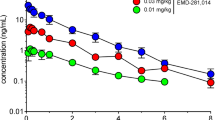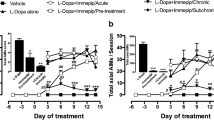Abstract
Sarizotan, a 5-HT1A agonist with additional affinity for D3 and D4 receptors, has been demonstrated to have anti-dyskinetic effects. The mechanism by which these effects occur is not clear. Using unilateral 6-hydroxydopamine-lesioned rats that received chronic intraperitoneal (ip) administration of l-3,4-dihydroxyphenylalanine (l-DOPA) we investigated the involvement of D3 and 5-HT1A receptors in the effects of sarizotan on contraversive circling and abnormal involuntary movements (AIMs). Before sensitization by chronic l-DOPA treatment (12.5 with 3.25 mg/kg benserazide ip, twice daily for 21 days), no effect of the selective D3 agonist, PD128907 (1 or 3 mg/kg ip), or the selective D3 antagonist, GR103691 (0.5 or 1.5 mg/kg ip), was observed. Treatment with sarizotan (1 or 5 mg/kg ip) dose-dependently inhibited the l-DOPA-induced contraversive turning and AIMs. In co-treatment with the 5-HT1A antagonist, WAY100635 (1 mg/kg ip), sarizotan failed to affect this behaviour, confirming the prominent 5-HT1A receptor-mediated mechanism of action. In the presence of PD128907 (3 mg/kg ip), the effects of sarizotan on contraversive turning, locomotive dyskinesia and axial dystonia, but not on orolingual and forelimb dyskinesia, were blocked. On its own, PD128907 had no effect on the behavioural effects of l-DOPA except that it tended to reduce orolingual and forelimb dyskinesia. GR103691 had no effect on its own or in combination with sarizotan. These data identify an involvement of D3 receptors in the action of sarizotan on some, but not all l-DOPA-induced motor side effects. This selective involvement is in contrast to the more general involvement of 5-HT1A receptors in the anti-dyskinetic effects of sarizotan.


Similar content being viewed by others
Abbreviations
- AIMs:
-
Abnormal involuntary movements
- ip:
-
Intraperitoneally and introperitoneal, respectively
- l-DOPA:
-
Levodopa, l-3,4-dihydroxyphenylalanine
- LID:
-
l-DOPA-induced dyskinesia
- PD:
-
Parkinson’s disease
- 5-HT:
-
Serotonin, 5-hydroxytryptamine
- 6-OHDA:
-
6-Hydroxydopamine
References
Ahlenius S, Henriksson I, Magnusson O, Salmi P (1999) In vivo intrinsic efficacy of the 5-HT1A receptor antagonists NAD-299, WAY-100, 635 and (S)-(−)-UH-301 at rat brain monoamine receptors. Eur Neuropsychopharmacol 9:15–19
Antonelli T, Fuxe K, Tomasini MC, Bartoszyk GD, Seyfried CA, Tanganelli S, Ferraro L (2005) Effects of sarizotan on the corticostriatal glutamate pathways. Synapse 58:193–199
Arai R, Horiike K, Hasegawa Y (1998) Dopamine-degrading activity of monoamine oxidase in locus coeruleus and dorsal raphe nucleus neurons. A histochemical study in the rat. Neurosci Lett 250:41–44
Audinot V, Newman-Tancredi A, Gobert A, Rivet JM, Brocco M, Lejeune F, Gluck L, Desposte I, Bervoets K, Dekeyne A, Millan MJ (1998) A comparative in vitro and in vivo pharmacological characterization of the novel dopamine D-3 receptor antagonists (+)-S 14297, nafadotride, GR 103, 691 and U 99194. J Pharmacol Exp Ther 287:187–197
Ba MW, Kong M, Ma GZ, Yang HQ, Lu GQ, Chen SD, Liu ZG (2007) Cellular and behavioral effects of 5-HT1A receptor agonist 8-OH-DPAT in a rat model of levodopa-induced motor complications. Brain Res 1127:177–184
Bara-Jimenez W, Bibbiani F, Morns MJ, Dimitrova T, Sherzai A, Mouradian MM, Chase T (2005) Effects of serotonin 5-HT1A agonist in advanced Parkinson’s disease. Mov Disord 20:932–936
Bartoszyk GD, van Amsterdam C, Greiner HE, Rautenberg W, Russ H, Seyfried CA (2004) Sarizotan, a serotonin 5-HT1A receptor agonist and dopamine receptor ligand. 1. Neurochemical profile. J Neural Transm 111:113–126
Bibbiani F, Oh JD, Chase TN (2001) Serotonin 5-HT1A agonist improves motor complications in rodent and primate parkinsonian models. Neurology 57:1829–1834
Bishop C, Taylor JL, Kuhn DM, Eskow KL, Park JY, Walker PD (2006) MDMA and fenfluramine reduce l-DOPA-induced dyskinesia via indirect 5-HT1A receptor stimulation. Eur J Neurosci 23:2669–2676
Bordet R, Ridray S, Carbon S, Diaz J, Sokoloff P, Schwartz JC (1997) Induction of dopamine D-3 receptor expression as a mechanism of behavioral sensitization to levodopa. Proc Natl Acad Sci USA 94:3363–3367
Brotchie JA (2005) Nondopaminergic mechanisms in levodopa-induced dyskinesia. Mov Disord 20:919–931
Carey RJ (1991) Chronic l-dopa treatment in the unilateral 6-OHDA rat-evidence for behavioral sensitization and biochemical tolerance. Brain Res 568:205–214
Carta M, Carlsson M, Kirik D, Björklund A (2007) Dopamine released from 5-HT terminals is the cause of l-dopa-induced dyskinesia in parkinsonian rats. Brain 130:1819–1833
Castaneda E, Fleming S, Paquette MA, Boat K, Moffett J, Stachowiak EK, Bloom DC, Stachowiak MK (2005) Assessment of recovery in the hemiparkinson rat: drug-induced rotation is inadequate. Physiol Behav 84:525–535
Cenci MA (2007) Dopamine dysregulation of movement control in l-DOPA-induced dyskinesia. Trends Neurosci 30:236–243
Cenci MA, Lee CS, Björklund A (1998) l-DOPA-induced dyskinesia in the rat is associated with striatal overexpression of prodynorphin- and glutamic acid decarboxylase mRNA. Eur J Neurosci 10:2694–2706
Cooper DR, Marrel C, Testa B, van de Waterbeemd H, Quinn N, Jenner P, Marsden CD (1984) l-Dopa methyl ester: a candidate for chronic systemic delivery of l-Dopa in Parkinson’s disease. Clin Neuropharmacol 7:89–98
Daly SA, Waddington JL (1993) Behavioral effects of the putative D-3 dopamine receptor agonist 7-OH-DPAT in relation to other D-2-like agonists. Neuropharmacology 32:509–510
Dekundy A, Lundblad M, Danysz W, Cenci MA (2007) Modulation of l-DOPA-induced abnormal involuntary movements by clinically tested compounds: further validation of the rat dyskinesia model. Behav Brain Res 179:76–89
Dupre KB, Eskow KL, Negron B, Bishop C (2007) The differential effects of 5-HT(1A) receptor stimulation on dopamine receptor-mediated abnormal involuntary movements and rotations in the primed hemiparkinsonian rats. Brain Res 1158:135–143
Eskow KL, Dupre KB, Barnum CJ, Dickinson SO, Park JY, Bishop C (2009) The role of the dorsal raphe nucleus in the development, expression, and treatment of l-dopa-induced dyskinesia in hemiparkinsonian rats. Synapse 63:610–620
Fox SH, Lang AE, Brotchie JM (2006) Translation of nondopaminergic treatments for levodopa-induced dyskinesia from MPTP-lesioned nonhuman primates to phase Ila clinical studies: keys to success and roads to failure. Mov Disord 21:1578–1594
Gerber R, Altar CA, Liebman JM (1998) Rotational behaviour induced by 7-hydroxy-DPAT, a putative 5-HT1A agonist, in 6-hydroxydopamine-lesioned rat. Psychopharmacology (Berlin) 94:178–182
Gerlach M, Riederer P (1996) Animal models of Parkinson’s disease: an empirical comparison with the phenomenology of the disease in man. J Neural Transm 103:987–1041
Gerlach M, van den Buuse M, Blaha C, Bremen D, Riederer P (2004) Entacapone increases and prolongs the central effects of l-DOPA in the 6-hydroxydopamine-lesioned rat. Naunyn Schmiedeberg’s Arch Pharmacol 370:388–394
Goetz CG, Damier P, Hicking C, Laska E, Müller T, Olanow CW, Rascol O, Russ H (2007) Sarizotan as a treatment for dyskinesias in Parkinson’s disease: a double-blind placebo-controlled trial. Mov Disord 22:179–186
Grégoire L, Samadi P, Graham J, Bédard PJ, Bartoszyk GD, Di Paolo T (2009) Low doses of sarizotan reduce dyskinesias and maintain antiparkinsonian efficacy of l-DOPA in parkinsonian monkeys. Parkinsonism Relat Disord 15:445–452
Henry B, Crossman AR, Brotchie JM (1999) Effect of repeated l-DOPA, bromocriptine, or lisuride administration on preproenkephalin-A and preproenkephalin-B mRNA levels in the striatum of the 6-hydroxydopamine-lesioned rat. Exp Neurol 155:204–220
Holmes A, Lachowicz JE, Sibley DR (2004) Phenotypic analysis of dopamine receptor knockout mice; recent insights into the functional specificity of dopamine receptor subtypes. Neuropharmacology 47:1117–1134
Hsu A, Togasaki DM, Bezard E, Sokoloff P, Langston JW, Di Monte DA, Quik M (2004) Effect of the D3 dopamine receptor partial agonist BP897N-4-(4-(2-methoxyphenyl)piperazinyl)butyl-2-naphthamide on l-3,4-dihydroxyphenylalanine-induced dyskinesias and parkinsonism in squirrel monkeys. J Pharmacol Exp Ther 311:770–777
Iravani MM, Jackson MJ, Kuoppamaki M, Smith LA, Jenner P (2003) 3,4-Methylene-dioxymethamphetamine (ecstasy) inhibits dyskinesia expression and normalizes motor activity in 1-methyl-4-phenyl-1,2,3,6-tetrahydropyridine-treated primates. J Neurosci 23:9107–9115
Jankovic JJ (2005) Motor fluctuations and dyskinesias in Parkinson’s disease: clinical manifestations. Mov Disord 20(Suppl 11):S11–S16
Jenner P (2008) Molecular mechanisms of l-DOPA-induced dyskinesia. Nat Rev Neurosci 9:665–677
Kostrzewa RM, Kostrzewa JP, Nowak P, Kostrzewa RA, Brus R (2004) Dopamine D-2 agonist priming in intact and dopamine-lesioned rats. Neurotoxicol Res 6:457–462
Lane EL, Cheetham SC, Jenner P (2006) Does contraversive circling in the 6-OHDA-lesioned rat indicate an ability to induce motor complications as well as therapeutic effects in Parkinson’s disease? Exp Neurol 197:284–290
Lévesque D, Diaz J, Pilon C, Martres MP, Giro B, Souil E, Schott D, Morgat JL, Schwartz JC, Sokoloff P (1992) Identification, characterization, and localization of the dopamine-D3 receptor in rat brain using 7-[3H]hydroxy-N,N-di-normal-propyl-2-aminotetralin. Proc Natl Acad Sci USA 89:8155–8159
Lundblad M, Andersson M, Winkler C, Kirik D, Wierup N, Cenci MA (2002) Pharmacological validation of behavioural measures of akinesia and dyskinesia in a rat model of Parkinson’s disease. Eur J Neurosci 15:120–132
Lundblad M, Picconi B, Lindgren H, Cenci MA (2004) A model of l-DOPA-induced dyskinesia in 6-hydroxydopamine lesioned mice: relation to motor and cellular parameters of nigrostriatal function. Neurobiol Dis 16:110–123
Marin C, Aguilar E, Rodrígues-Oroz MC, Bartoszyk GD, Obeso JA (2009) Local administration of sarizotan into the subthalamic nucleus attenuates levodopa-induced dyskinesias in 6-OHDA-lesioned rats. Psychopharmacology 204:241–250
Matsubara K, Shimizu K, Suno M, Ogawa K, Awaya T, Yamada T, Noda T, Satomi M, Ohtaki K, Chiba K, Tasaki Y, Shiono H (2006) Tandospirone, a 5-HT1A agonist, ameliorates movement disorder via non-dopaminergic systems in rats with unilateral 6-hydroxydopamine-generated lesions. Brain Res 1112:126–133
Mignon L, Wolf WA (2007) Postsynaptic 5-HT1A receptor stimulation increases motor activity in the 6-hydroxydopamine-lesioned rat: implications for treating Parkinson’s disease. Psychopharmacology 192:49–59
Millan MJ, Seguin L, Gobert A, Cussac D, Brocco M (2004) The role of dopamine D-3 compared with D-2 receptors in the control of locomotor activity: a combined behavioural and neurochemical analysis with novel, selective antagonists in rats. Psychopharmacology 174:341–357
Müller T, Russ H (2006) Levodopa, motor fluctuations and dyskinesia in Parkinson’s disease. Expert Opin Pharmacol 7:1715–1730
Nadjar A, Gerfen CR, Bezard E (2009) Priming for l-dopa-induced dyskinesia in Parkinson’s disease: a feature inherent to the treatment or the disease? Prog Neurobiol 87:1–9
Olanow CW, Damier P, Goetz CG, Mueller T, Nutt J, Rascol O, Serbanescu A, Deckers F, Russ H (2004) Multicenter, open-label, trial of sarizotan in Parkinson disease patients with levodopa-induced dyskinesias (the SPLENDID study). Clin Neuropharmacol 27:58–62
Paxinos G, Watson C (1997) The rat brain in stereotaxic coordinates, 3rd edn. Academic Press, New York
Pugsley TA, Davis MD, Akunne HC, MacKenzie RG, Shih YH, Damsma G, Wikstrom H, Whetzel SZ, Georgic LM, Cooke LW, Demattos SB, Corbin AE, Glase SA, Wise LD, Dijkstra D, Heffner TG (1995) Neurochemical and functional characterization of the preferentially selective dopamine D3 agonist PD 128907. J Pharmacol Exp Ther 275:1355–1366
Rylander D, Parent M, O’Sullivan SS, Dovero S, Lees AJ, Bezard E, Descarries L, Cenci MA (2010) Maladaptive plasticity of serotonin axon terminals in levodopa-induced dyskinesia. Ann Neurol 68:619–628
Sautel F, Griffon N, Sokoloff P, Schwartz JC, Launay C, Simon P, Costentin J, Schoenfelder A, Garrido F, Mann A, Wermuth CG (1995) Nafadotride, a potent preferential dopamine D-3 receptor antagonist, activates locomotion in rodents. J Pharmacol Exp Ther 275:1239–1246
Srinivasan J, Schmidt WJ (2004) The effect of the α2-adrenoreceptor antagonist idazoxin against 6-hydroxydopamine-induced Parkinsonism in rats: multiple facets of action? Naunyn Schmiedeberg’s Arch Pharmacol 369:629–638
Svensson K, Carlsson A, Waters N (1994) Locomotor inhibition by the D-3 ligand R-(+)-7-OH-DPAT is independent of changes in dopamine release. J Neural Transm (Gen Sect) 95:71–74
Ungerstedt U, Arburthnott GW (1970) Quantitative recording of rotational behaviour in rats after 6-hydroxydopamine lesions in the nigrostriatal dopamine system. Brain Res 24:485–493
Visanji NP, Millan MJ, Brotchie JM (2006) Actions at sites other than D-3 receptors mediate the effects of BP897 on l-DOPA-induced hyperactivity in monoamine-depleted rats. Exp Neurol 202:85–92
Zeng BY, Iravani MM, Jackson MJ, Rose S, Parent A, Jenner P (2010) Morphological changes in serotoninergic neurites in the striatum and globus pallidus in levodopa primed MPTP treated common marmosets with dyskinesia. Neurobiol Dis 40:599–607
Acknowledgment
This study was funded by Merck KGaA (Darmstadt, Germany) without restriction.
Conflict of interest
The authors declare that they have no conflict of interest.
Author information
Authors and Affiliations
Corresponding author
Rights and permissions
About this article
Cite this article
Gerlach, M., Bartoszyk, G.D., Riederer, P. et al. Role of dopamine D3 and serotonin 5-HT1A receptors in l-DOPA-induced dyskinesias and effects of sarizotan in the 6-hydroxydopamine-lesioned rat model of Parkinson’s disease. J Neural Transm 118, 1733–1742 (2011). https://doi.org/10.1007/s00702-010-0571-8
Received:
Accepted:
Published:
Issue Date:
DOI: https://doi.org/10.1007/s00702-010-0571-8




